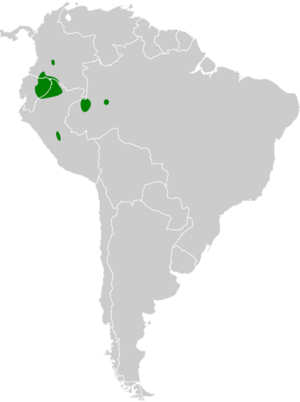Rio Suno antwren facts for kids
Quick facts for kids Rio Suno antwren |
|
|---|---|
| Conservation status | |
| Scientific classification | |
| Genus: |
Myrmotherula
|
| Species: |
sunensis
|
 |
|
The Rio Suno antwren (scientific name: Myrmotherula sunensis) is a small bird that belongs to a group called "typical antbirds." You can find this bird in parts of Brazil, Colombia, Ecuador, and Peru.
Contents
About the Rio Suno Antwren
Different Types of Rio Suno Antwrens
The Rio Suno antwren has two main types, called subspecies. They are M. s. sunensis, first described by Chapman in 1925, and M. s. yessupi, described by James Bond in 1950.
Some scientists think the Rio Suno antwren might be closely related to the slaty antwren and Salvadori's antwren. They look, act, and sound similar.
What Does the Rio Suno Antwren Look Like?
The Rio Suno antwren is a small bird, about 9 centimeters (3.5 inches) long. It has a short tail.
Male birds of the M. s. sunensis type are mostly gray. They have a hidden white patch between their shoulders. Their wings are a darker gray with white tips. Their throat and upper chest are black.
Female birds of this type have olive-brown feathers on their upper parts. Their tail and wings are browner. Their undersides are a dull, light brown with a reddish tint.
Young males look a lot like adult females. However, they start to show some black feathers on their throat and chest.
Males of the M. s. yessupi type look similar to the M. s. sunensis males. The females of M. s. yessupi are grayer on top and less reddish on their undersides.
Where Do Rio Suno Antwrens Live?
The Rio Suno antwren lives in different, separate areas.
The M. s. sunensis type is found in south-central Meta Department and Putumayo Department in southern Colombia. It also lives in eastern Ecuador, reaching as far as Pastaza Province.
The M. s. yessupi type lives in east-central Peru, in the Huánuco and Pasco areas. It also extends into southwestern Brazil, near the Rio Juruá.
These birds prefer to live in the lower and middle parts of evergreen forests. They also live in older secondary forests in lowlands and foothills. In Colombia and Ecuador, they mostly live in "terra firme" forests, which are not flooded. In Brazil, they are found in "várzea" forests (which flood) and forests that are changing.
They seem to like areas with thick, viney plants, especially those with many Heliconia plants. They usually live at elevations between 200 and 500 meters (about 650 to 1,600 feet) above sea level. Sometimes, they can be found as high as 900 meters (about 3,000 feet).
Behavior and Life Cycle
Movement
Scientists believe that the Rio Suno antwren stays in the same area all year round. It does not migrate.
Feeding Habits
We don't know all the details about what the Rio Suno antwren eats. However, it probably mostly eats insects and spiders.
It often looks for food alone, in pairs, or with its family. It usually joins groups of different bird species that are feeding together. This bird typically searches for food in thick plants, usually between 1 and 7 meters (about 3 to 23 feet) above the ground.
It doesn't move as quickly or acrobatically as some other antwrens when looking for food. It mostly picks prey off leaves. It also finds food in bunches of dead leaves, tangled vines, and along branches.
Reproduction
Right now, scientists do not know anything about how the Rio Suno antwren breeds or raises its young.
What Does the Rio Suno Antwren Sound Like?
The Rio Suno antwren's song is described as a clear, melodic sound: "wi-weedy-weedy-weedy." Its call is a thin, rising sound like "wheet," which it often says twice.
Conservation Status
The IUCN (International Union for Conservation of Nature) has evaluated the Rio Suno antwren. They have listed it as a species of "Least Concern." This means it is not currently in danger of disappearing.
However, its population size is not known, and it is thought to be decreasing. No immediate threats have been found. The bird is considered rare to uncommon in the areas where it lives.
It can be found in a few protected areas. But more research is needed to understand exactly where it lives and how many there are. This will help scientists better protect this species.


